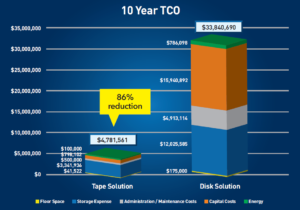
Modern tape storage has long been recognized for its low cost. Several analyst white papers have been published that demonstrate the low cost of storing data on tape. For example, “Quantifying the Economic Benefits of LTO-8 Technology” is a white paper that can be found on the LTO.org website. However, occasionally a storage solution provider publishes a white paper that claims to show that their solution is less expensive than tape storage for a particular use case. A good example is a recent white paper published by a disk-based backup-as-a-service provider who will remain unidentified out of respect for what they do. For the purpose of this blog, let’s call them “BaaS.” So let’s dig into their analysis which makes several assumptions that result in higher costs for tape storage than most users would experience.
Total Cost of Ownership (TCO) Process
The first step in developing a Total Cost of Ownership (TCO) estimate is the determination of the amount of data to be stored. The BaaS whitepaper separates the amount of primary data, which we wish to protect, from backup data, which is the data physically stored on the backup media. They estimate the amount of backup data residing in the tape library to be two to four times the primary data. This is due to their use of the old daily/ weekly/monthly/ full backup methodology for estimating the amount of backup data. The result is that two to four times the amount of primary data ends up being stored on tape, raising the tape hardware and media costs by two to four times.
Furthermore, for the BaaS solution, the ratio of backup to primary data is .5X to 2X. They claim they are incremental forever, and in-line compression reduces the amount of backup data required. However, today’s reality is that the incremental forever methodology is used by popular data protection software suppliers with tape storage, providing the same reduction in backup data requirements. Also, modern data protection solutions incorporate disk storage cache, snapshots, and deduplication that all provide significant benefits and integrate with tape storage.
In addition, the capital costs for the tape solution in the BaaS white paper are significantly overstated. BaaS estimates that the five-year capital cost of tape drives, libraries, and media servers as $150/TB to $250/TB and amortizes these costs over five years to generate an annualized capital costs of $30-$50/TB/Year. Using the Fujifilm TCO tool, we can estimate tape storage capital costs, including library, drives, and media. For one PB of backup storage, the total five-year capital cost is $35.56/TB or a little over $7 TB/Year. It is also worth noting that a tape library typically is used for longer than five years, so even the $7/TB/Year is on the high side of the tape solution capital costs.
Role of Management Costs

With just these two adjustments the cost of tape backup storage is $34/TB/Year less expensive than the BaaS tape storage estimates. Further, if the ratio of backup data to primary data is the same and we accept the average of all the other tape cost assumptions made by Baas, we would find that the tape solution is 50% less expensive than the BaaS white paper claims. This would not be surprising as typical TCO models show as much as an 86% lower TCO for tape compared to disk.
It is also worth noting that it would be a rare organization that keeps only one copy of backup data. Most organizations require multiple copies, with one of them on tape media. Tape storage by its nature can be easily stored off-line and this provides protection against malware via a tape air gap. Tape is also very energy efficient, and with the large amounts of data that organizations must backup, this is a significant benefit. Given the importance of data security considerations and its low costs, tape will continue to be a vital component of a robust data protection architecture.
